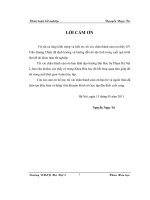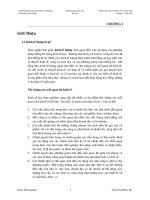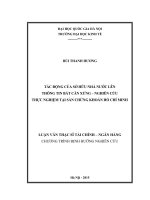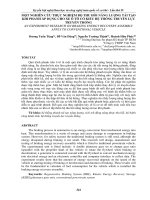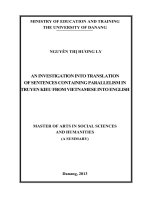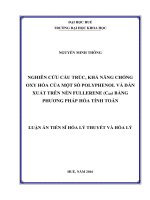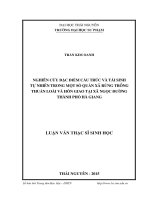Nghiên cứu thực nghiệm cấu trúc phổ năng lượng kích thích của các hạt nhân 172yb và 153sm trên kênh nơtron của lò phản ứng hạt nhân đà lạt
Bạn đang xem bản rút gọn của tài liệu. Xem và tải ngay bản đầy đủ của tài liệu tại đây (7 MB, 152 trang )
MINISTRY OF EDUCATION AND
TRAINING
MINISTRY OF SCIENCE AND
TECHNOLOGY
Vietnam Atomic Energy Institute
———————
NGUYỄN NGỌC ANH
EXPERIMENTAL STUDY ON LEVEL STRUCTURE
OF EXCITED 172 Yb AND 153 Sm NUCLEI USING
NEUTRON BEAM FROM DALAT NUCLEAR
RESEARCH REACTOR
DOCTORAL DISSERTATION IN PHYSICS
HÀ NỘI - 2018
MINISTRY OF EDUCATION AND
TRAINING
MINISTRY OF SCIENCE AND
TECHNOLOGY
Vietnam Atomic Energy Institute
———————
NGUYỄN NGỌC ANH
EXPERIMENTAL STUDY ON LEVEL STRUCTURE OF
EXCITED 172 Yb AND 153 Sm NUCLEI USING NEUTRON
BEAM FROM DALAT NUCLEAR RESEARCH REACTOR
DOCTORAL DISSERTATION IN PHYSICS
Subject: Atomic and Nuclear Physics
Code: 9 44 01 06
Supervisors:
1. Dr. Nguyễn Xuân Hải
2. Assoc. Prof. Dr. Phạm Đình Khang
HÀ NỘI - 2018
iii
Declaration of Authorship
I declare that this thesis titled, “Experimental study on level structure of excited
172
Yb and 153 Sm nuclei using neutron beam from Dalat nuclear research reactor”
and the work presented in it are my own under the guidance of my supervisors,
and have not been published by anyone else in any other works or articles. A
part of the results has been published in a peer-review journal and proceeding
of 23rd International Seminar on Interaction of Neutrons with Nuclei held in
Dubna, Russia written in co-authorship with my supervisors and collaborators.
The other part is in preliminary, and we expect to collect more experimental data
before publishing.
v
Acknowledgements
I would like to express my deep gratitude to my supervisors, Dr. Nguyễn Xuân
Hải and Assoc. Prof. Dr. Phạm Đình Khang for their guidance, support and
encouragement during my research work. They provided me not only the motivation and the important knowledge, but also the financial support for my life
from 2013 to 2015 in Đà Lạt.
I would like to thank Dr. A. M. Sukhovoj for his great guidance. He taught me
how to become an honest and effective analyst.
I would like also to thank Assoc. Prof. Dr. Nguyễn Quang Hưng for his interesting conversations and his important suggestions for my research since 2016.
I thank Assoc. Prof. Dr. Nguyễn Mậu Chung, my graduate supervisor for the
valuable fundamental knowledge that he gave me during my graduate studies.
I am grateful to Dalat Nuclear Research Institute and Nuclear Training Center,
Vietnam Atomic Energy Institute for their significant supports to my research.
I also thank my colleagues at Center for Nuclear Physics and Nuclear Electronics,
Training and Education Center, and Reactor Center for their kind help during my
experiment.
I am thankful to Ms. Nguyễn Thúy Hằng and Ms. Nguyễn Thị Diệu Huyền for
their kind assistant during my PhD study.
I also wish to thank Lâm’s photocopy shop, 27 Nguyễn Công Trứ, Đà Lạt, for
financial support to print my dissertation.
Finally, I am deeply indebted to my family for their continuous encouragement
and constant confidence in me.
vii
Contents
Declaration of Authorship
iii
Acknowledgements
v
List of Figures
xi
List of Tables
xv
List of Abbreviations
xvii
Introduction
1
1
Theory
11
1.1
Compound nuclear reaction . . . . . . . . . . . . . . . . . . . . . . .
11
1.1.1
Bohr-independence hypothesis . . . . . . . . . . . . . . . . .
11
1.1.2
Reciprocity theorem . . . . . . . . . . . . . . . . . . . . . . .
13
1.2
Nuclear level scheme . . . . . . . . . . . . . . . . . . . . . . . . . . .
13
1.3
Nuclear level density . . . . . . . . . . . . . . . . . . . . . . . . . . .
16
1.3.1
Fermi-gas model . . . . . . . . . . . . . . . . . . . . . . . . .
18
1.3.1.1
Systematics of the Fermi-gas parameters . . . . . .
21
1.3.1.2
Parity ratio . . . . . . . . . . . . . . . . . . . . . . .
24
1.3.2
Constant temperature model . . . . . . . . . . . . . . . . . .
25
1.3.3
Gilbert-Cameron model . . . . . . . . . . . . . . . . . . . . .
26
1.3.4
Generalized superfluid model . . . . . . . . . . . . . . . . .
27
1.3.5
Microscopic-based models . . . . . . . . . . . . . . . . . . . .
29
1.4
Radiative strength function . . . . . . . . . . . . . . . . . . . . . . .
33
1.5
Conclusion of chapter 1 . . . . . . . . . . . . . . . . . . . . . . . . .
37
viii
2
Experiment and data analysis
39
2.1
39
Experimental facility and experimental method . . . . . . . . . . . .
2.1.1
2.2
2.3
3
Dalat Nuclear Research Reactor and the neutron beam-port
No.3 . . . . . . . . . . . . . . . . . . . . . . . . . . . . . . . .
39
2.1.2
The γ − γ coincidence method . . . . . . . . . . . . . . . . .
41
2.1.3
γ − γ coincidence spectrometer . . . . . . . . . . . . . . . . .
44
2.1.3.1
Electronic setup and operation principle . . . . . .
44
2.1.3.2
Main properties . . . . . . . . . . . . . . . . . . . .
46
2.1.4
Experimental setup and target information . . . . . . . . . .
49
2.1.5
Sources of “systematic” errors in γ − γ coincidence method
51
Data Analysis . . . . . . . . . . . . . . . . . . . . . . . . . . . . . . .
56
2.2.1
Pre-analysis . . . . . . . . . . . . . . . . . . . . . . . . . . . .
57
2.2.2
Two-step cascade spectra . . . . . . . . . . . . . . . . . . . .
61
2.2.3
Determination of gamma cascade intensity . . . . . . . . . .
65
2.2.4
Construction of nuclear level scheme . . . . . . . . . . . . .
66
2.2.5
Determination of gamma cascade intensity distributions . .
67
2.2.6
Extraction of nuclear level density and radiative strength
function . . . . . . . . . . . . . . . . . . . . . . . . . . . . . .
69
2.2.6.1
Basic ideas and underlying assumption . . . . . . .
69
2.2.6.2
Determination of the functional form of the γ-rays
transmission coefficient . . . . . . . . . . . . . . . .
72
2.2.6.3
Determination of nuclear level density . . . . . . .
76
2.2.6.4
Determination of radiative strength function
. . .
78
Conclusion of chapter 2 . . . . . . . . . . . . . . . . . . . . . . . . .
79
Results and discussion
3.1
Nuclear level scheme of 172 Yb and 153 Sm
81
. . . . . . . . . . . . . . .
81
3.1.1
172
Yb . . . . . . . . . . . . . . . . . . . . . . . . . . . . . . . .
81
3.1.2
153
Sm . . . . . . . . . . . . . . . . . . . . . . . . . . . . . . . .
92
3.2
Gamma cascade intensity distributions of 172 Yb . . . . . . . . . . . .
97
3.3
Nuclear level density and radiative strength function of 172 Yb . . . 105
ix
3.4
3.3.1
Comparison with other experimental data . . . . . . . . . . 108
3.3.2
Comparison with theoretical models . . . . . . . . . . . . . . 111
3.3.2.1
Nuclear level density . . . . . . . . . . . . . . . . . 111
3.3.2.2
Radiative strength function . . . . . . . . . . . . . . 111
Conclusion of chapter 3 . . . . . . . . . . . . . . . . . . . . . . . . . 114
Summary and outlook
115
List of publications
117
References
118
xi
List of Figures
1.1
2.1
2.2
2.3
2.4
2.5
2.6
2.7
2.8
2.9
2.10
2.11
2.12
2.13
2.14
2.15
2.16
β − -decay with
from 60
Nuclear level scheme of 60
27 Co33
28 Ni32
T1/2 =1925.8 days extracted from ENSDF library. . . . . . . . . . . . .
The horizontal cross-section view of the DNRR. . . . . . . . . . . .
The detail structure of the neutron beam-port No. 3. . . . . . . . .
Two-step gamma cascades corresponding to the decays from a
compound state. . . . . . . . . . . . . . . . . . . . . . . . . . . . . . .
The γ − γ coincidence electronics. . . . . . . . . . . . . . . . . . . . .
The TAC amplitude spectrum measured with 60 Co. . . . . . . . . .
The channel-energy relationship of the two detectors. Data of the
detector B has an offset of 1000 on y-axis. . . . . . . . . . . . . . . .
The energy resolution of the two detectors in the energy range from
0.5 MeV to 8 MeV. . . . . . . . . . . . . . . . . . . . . . . . . . . . . .
The relative efficiencies of the two detectors. . . . . . . . . . . . . .
Experimental setup for measuring the γ − γ coincidences. . . . . .
Experimental system at the neutron beam-port No. 3 of the DNRR.
An illustration for a three-step cascade. . . . . . . . . . . . . . . . .
Illustration of the cross talk effect. BS: Compton backscattered photon; Ann: annihilation photon. . . . . . . . . . . . . . . . . . . . . .
Data analysis procedure. . . . . . . . . . . . . . . . . . . . . . . . . .
The discrepancy between two datasets. Dataset A is collected from
detector A and dataset B is collected from detector B. . . . . . . . .
Dataset B is corrected according to dataset A. . . . . . . . . . . . . .
Summation spectrum for 171 Yb(n,2γ) reaction. E1 +E2 is sum of energies measured from two detectors. Energies (in keV) of the final
levels in the cascades are pointed near the peaks of the full absorption energy. The notations SE and DE correspond to the single- and
double-escape peaks, respectively. . . . . . . . . . . . . . . . . . . .
15
40
40
42
45
47
48
48
49
50
51
52
54
57
58
59
60
xii
2.17 Summation spectrum for 152 Sm(n,2γ) reaction. E1 + E2 is sum of
energies measured from two detectors. Energies (in keV) of the
final levels in the cascades are pointed near the peaks of the full
absorption energy. . . . . . . . . . . . . . . . . . . . . . . . . . . . . .
2.18 Explanation of the input variables used in the procedure of obtaining the TSC spectra given in Fig. 2.19. . . . . . . . . . . . . . . . . .
2.19 Detail procedure for obtaining the TSC spectra. . . . . . . . . . . . .
2.20 a. experimental TSC spectrum; b. simulated TSC spectrum, c. unresolved TSC spectrum with noise line, d. unresolved TSC spectrum without noise line corresponding to the decays from the compound state to the ground state of 172 Yb. . . . . . . . . . . . . . . . .
2.21 Procedure of extracting the NLD and RSF. . . . . . . . . . . . . . . .
2.22 Illustration of the shifting procedure for 172 Yb nucleus with Em =
3.625 MeV, Em = 3.875 MeV and Efmax = 1.198 MeV. The superposed energy range is between the two vertical arrows. The
curve (1) simulates the standard dataset (circle), while the curve
(2) models the to-be-shifted dataset (triangle). The k factor is the
ratio between the area under the curve (1) and that under the
curve (2). The two curves have the form of an exponential function C0 exp(C1 E), whose parameters (C0 , C1 ) are obtained via the
fitting to the corresponding datasets. . . . . . . . . . . . . . . . . .
2.23 The final dataset describes the functional form of γ-rays transmission coefficient of 172 Yb nucleus in the energy region from 0.5 to
7.5 MeV. The line is the average values over an 250 keV energy
interval. . . . . . . . . . . . . . . . . . . . . . . . . . . . . . . . . . .
2.24 Comparison of the γ-rays transmission coefficients of 172 Yb nucleus obtained by different starting excitation-energy bins. Histogram with black color is the average of the γ-rays transmission
coefficients obtained by all the starting excitation-energy bins from
2.125 MeV to 5.375 MeV. The corresponding uncertainties are given
by upper and lower lines. . . . . . . . . . . . . . . . . . . . . . . . .
3.1
3.2
TSC spectrum corresponding to the ground state of 172 Yb. . . . . .
TSC spectrum corresponding to the final level with the energy Ef =
78.8 keV of 172 Yb. . . . . . . . . . . . . . . . . . . . . . . . . . . . . .
60
62
64
68
71
73
75
76
88
89
xiii
3.3
3.4
3.5
3.6
3.7
3.8
3.9
3.10
3.11
3.12
3.13
Experimental level scheme of 172 Yb obtained within the gamma
cascades from compound state to six distinct low-lying discrete
levels with spin from 0¯
h to 2¯h. Explanation of the figure is given in
text. . . . . . . . . . . . . . . . . . . . . . . . . . . . . . . . . . . . . .
TSC spectrum corresponding to the final levels with energies Ef =
0 and 7.8 keV of 153 Sm. . . . . . . . . . . . . . . . . . . . . . . . . . .
TSC spectrum corresponding to the final level with the energy Ef
= 35.8 keV of 153 Sm. . . . . . . . . . . . . . . . . . . . . . . . . . . . .
NLS of 153 Sm obtained within this present work. Explanation of
the figure is the same as in Fig. 3.3. . . . . . . . . . . . . . . . . . . .
The gamma cascade intensity distributions of 172 Yb obtained
within the present work. . . . . . . . . . . . . . . . . . . . . . . . .
The extracted NLD and RSF of 172 Yb obtained within the present
work. . . . . . . . . . . . . . . . . . . . . . . . . . . . . . . . . . . . .
Comparison between the experimental gamma cascade intensity
distributions and the calculated one obtained from the extracted
NLD and RSF. . . . . . . . . . . . . . . . . . . . . . . . . . . . . . . .
Comparison between the NLD obtained within the present work
and the other experimental data. Explanation for this figure is
given in text. . . . . . . . . . . . . . . . . . . . . . . . . . . . . . . .
Comparison between the RSF obtained within the present work
and the other experimental data. Explanation of this figure is given
in text. . . . . . . . . . . . . . . . . . . . . . . . . . . . . . . . . . . .
Comparison between the NLD obtained within the present work
and a few common theoretical models. . . . . . . . . . . . . . . . . .
Comparison between RSF obtained within this work and few theoretical models. See explanation of the figure in text. . . . . . . . .
91
95
95
96
98
106
107
109
110
112
113
xv
List of Tables
2.1
2.2
Selected parameters of the electric modules. . . . . . . . . . . . . . .
Parameters of the relative efficiency functions. . . . . . . . . . . . .
3.1
Primary and secondary gamma-ray energies and absolute intensities obtained from the 171 Yb(nth , γ) reaction. The experimental
values are compared with the ENSDF data. . . . . . . . . . . . . . .
Primary and secondary gamma-ray energies and absolute intensities obtained from the 152 Sm(nth , γ) reaction. The experimental
values are compared with the ENSDF data. . . . . . . . . . . . . . .
The gamma cascade intensity distribution of 172 Yb and the contribution of the resolved cascades. . . . . . . . . . . . . . . . . . . . . .
3.2
3.3
46
49
81
93
99
xvii
List of Abbreviations
NLS
NLD
RSF
CTM
BSFG
GSM
ENSDF
HFBCS
DNRI
DNRR
KMF
TSC
Nuclear Level Scheme
Nuclear Level Density
Radiative Strength Function
Constant Temperature Model
Back-Shifted Fermi Gas
Generalized Superfluid Model
Evaluated Nuclear Structure Data File
Hartree-Fork plus Bardeen-Cooper-Schrieffer
Dalat Nuclear Research Institute
Dalat Nuclear Research Reactor
Kadmenskij Markushev Furman model
Two- Step Cascade
xix
Dedicated to my family
1
Introduction
Level structure of atomic nuclei, including nuclear level scheme (NLS), nuclear
level density (NLD), and radiative strength function (RSF), are all together important quantities, which carry fundamental information on the structure and
properties of excited nuclei. For NLS, its completeness plays important roles for
the study of not only nuclear reaction and statistical model calculations but also
adjustment of the nuclear level density parameters. Ideally, the completeness of
NLS can be obtained by studying the spectroscopic data from non-selective reactions. However, in practice, it is almost impossible due to experimental conditions and the complex of gamma spectrum [1]. Therefore, the only way to obtain
a complete NLS is to study through various experiments and combine their results together. Most of the NLS data were compiled in the ENSDF library [2]
containing about 187,067 datasets for 3,312 atomic nuclei collected from various
experiments including beta decay, electron capture, neutron inelastic scattering,
compound nuclear reactions induced by ions such as (3 He, 3 He’γ), (α, α’), (p, d),
(d, t), etc. However, information on the excited states and their corresponding
primary and/or secondary transitions of many nuclei in the intermediate energy
region, where the thermal neutron capture (nth ,γ) reaction was mostly employed
to extract the data, is still sparse and incomplete.
Regarding the NLD and RSF, although they are important quantities for the study
in many fields such as low-energy nuclear reactions, astrophysical nucleonsynthesis, nuclear energy production, transmutation of nuclear waste, nuclear reactor design, there is still lacking a lot of experimental data in the literature, in both
2
low- and high-energy regions.
It has been well-known that the γ − γ coincidence method [3] can be used to
study the NLS, NLD and RSF. Within this method, the cascade events, which
are obtained from the decay of the initial compound state to the different final
states, are separated into different Two-Step-Cascade (TSC) spectra. Particularly,
only correlated gamma transitions are detected, therefore the number of γ-rays
contributed to the TSC spectra is less than that presented in a normal prompt
gamma spectrum, leading to the significant reduction of the overlapping γ-rays
as well as improving the detecting ability of this method. In addition, different from the normal gamma spectra, the TSC spectra obtained using the γ − γ
coincidence method, after applying the background subtraction algorithm, have
almost no Compton background. Therefore, the detection limit of the coincidence
method is much improved in comparison with the normal gamma spectra analysis method. Beside that, the state from which a secondary gamma transition is
decayed can be determined in the coincidence method if one of the two γ-rays in
the cascade is a known primary transition. Based on these above advantages, the
γ − γ coincidence method is appropriate for the determination of excited states
with low spin in the energy region from 0.5 MeV to Bn − 0.5 MeV (Here, Bn is the
neutron binding energy). Furthermore, the γ − γ coincidence method can also be
used to determine the gamma cascade intensity distributions, which are related
to the NLD and RSF [see e.g. Eq. (2.1)]. Therefore, it is possible to determine the
experimental NLD and RSF based on this method.
Nuclear level scheme of 172Yb and 153Sm
172
Yb and 153 Sm are two deformed and rare earth nuclei. Their NLS are absolutely
necessary for either confirming or enhancing the predictive powers of the nuclear
3
models for heavy nuclei. The adopted nuclear levels and gamma transitions of
172
Yb and
153
Sm are given in Ref. [4] and Ref. [5], respectively. A summary of
important investigations on the NLS of these two nuclei is presented as follows.
For 172 Yb
NLS of 172 Yb has been thoroughly studied in different methods such as beta decay
of
172
Tm [6], electron capture decay of
low-lying states in
172,174
172
Lu [7], neutron inelastic scattering for
Yb [8], (n, n’γ) reactions using fast neutrons from reac-
tors [9], 170 Er(α,2n)172 Yb reaction for high-spin states [10], 171 Yb(n,γ) reaction for
low-spin states [11, 12]. Additional methods, which are also able to provide the
level scheme of 172 Yb based on the compound nuclear reactions induced by light
ions, include
[16],
173
172
Yb(3 He,3 He’γ) [13],
(d,t) [17],
173
172
Yb(α,α’) [14],
Yb(3 He,γ), (3 He,αγ) [17, 18],
170
173
Yb(p,d) [15],
171
Yb(d,p)
Yb(t,p) [19], and elastic and
inelastic proton scatterings [20, 21]. Furthermore, lifetimes of a number of levels
have been also determined via the
172
Yb(γ, γ’) reactions using the nuclear reso-
nance fluorescence [22] and Coulomb excitation [23, 24] methods. Through these
experiments, the low-lying discrete level scheme of
172
Yb in the low-energy re-
gion (E < 2.4 MeV) has been well understood [4]. In this low-energy region,
energies of the levels were determined with the accuracy of ten to hundred eV,
whereas spins and parities were also identified for a majority of levels. However,
information on the excited states and their corresponding primary transitions in
the intermediate energy region (2.4 MeV < E < 5 MeV), where the thermal neutron capture reactions (nth ,γ) were mostly employed to extract the data, is sparse
and incomplete.
In particular, based on the neutron capture reaction with both thermal and 2

